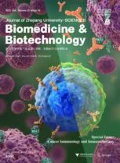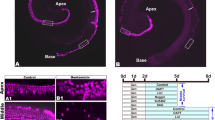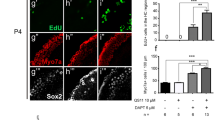Abstract
More than 80% of all cases of deafness are related to the death or degeneration of cochlear hair cells and the associated spiral ganglion neurons, and a lack of regeneration of these cells leads to permanent hearing loss. Therefore, the regeneration of lost hair cells is an important goal for the treatment of deafness. Atoh1 is a basic helix-loop-helix (bHLH) transcription factor that is critical in both the development and regeneration of cochlear hair cells. Atoh1 is transcriptionally regulated by several signaling pathways, including Notch and Wnt signalings. At the post-translational level, it is regulated through the ubiquitin-proteasome pathway. In vitro and in vivo studies have revealed that manipulation of these signaling pathways not only controls development, but also leads to the regeneration of cochlear hair cells after damage. Recent progress toward understanding the signaling networks involved in hair cell development and regeneration has led to the development of new strategies to replace lost hair cells. This review focuses on our current understanding of the signaling pathways that regulate Atoh1 in the cochlea.
摘 要
Atoh1 属于bHLH 转录因子家族成员, 其对耳蜗毛细胞的胚胎发育及损伤后再生具有重要作用。 许多讯号通道在转录水平上对 Atoh1 有调节作用, 包括 Notch 和 Wnt 通道。 在蛋白转译后水平, Atoh1 是经由泛素-蛋白酶通道所调节。 体外细胞实验及体内动物实验都显示: 经由上述讯号通道的调节手段不仅影响耳蜗发育, 也导致毛细胞的损伤后再生。 本综述回顾了耳蜗内各个对 Atoh1 调节讯号通道研究的进展, 并聚焦于泛素-蛋白酶通道对 Atoh1 进行转译后调节及其对毛细胞发 育的影响。
Similar content being viewed by others
References
Akil, O., Seal, R.P., Burke, K., et al., 2012. Restoration of hearing in the VGLUT3 knockout mouse using virally mediated gene therapy. Neuron, 75(2): 283–293. https://doi.org/10.1016/j.neuron.2012.05.019
Askew, C., Rochat, C., Pan, B., et al., 2015. Tmc gene therapy restores auditory function in deaf mice. Sci. Transl. Med., 7(295): 295ra108. https://doi.org/10.1126/scitranslmed.aab1996
Atkinson, P.J., Wise, A.K., Flynn, B.O., et al., 2014. Hair cell regeneration after ATOH1 gene therapy in the cochlea of profoundly deaf adult guinea pigs. PLoS ONE, 9(7): e102077. https://doi.org/10.1371/journal.pone.0102077
Ayrault, O., Zhao, H., Zindy, F., et al., 2010. Atoh1 inhibits neuronal differentiation and collaborates with Gli1 to generate medulloblastoma-initiating cells. Cancer Res., 70(13): 5618–5627. https://doi.org/10.1158/0008-5472.CAN-09-3740
Ben-Arie, N., McCall, A.E., Berkman, S., et al., 1996. Evolutionary conservation of sequence and expression of the bHLH protein atonal suggests a conserved role in neurogenesis. Hum. Mol. Genet., 5(9): 1207–1216. https://doi.org/10.1093/hmg/5.9.1207
Ben-Arie, N., Bellen, H.J., Armstrong, D.L., et al., 1997. Math1 is essential for genesis of cerebellar granule neurons. Nature, 390(6656): 169–172. https://doi.org/10.1038/36579
Ben-Arie, N., Hassan, B.A., Bermingham, N.A., et al., 2000. Functional conservation of atonal and Math1 in the CNS and PNS. Development, 127(5): 1039–1048.
Bermingham, N.A., Hassan, B.A., Price, S.D., et al., 1999. Math1: an essential gene for the generation of inner ear hair cells. Science, 284(5421): 1837–1841. https://doi.org/10.1126/science.284.5421.1837
Bertrand, N., Castro, D.S., Guillemot, F., 2002. Proneural genes and the specification of neural cell types. Nat. Rev. Neurosci., 3(7): 517–530. https://doi.org/10.1038/nrn874
Bossuyt, W., Kazanjian, A., de Geest, N., et al., 2009. Atonal homolog 1 is a tumor suppressor gene. PLoS Biol., 7(2): e1000039. https://doi.org/10.1371/journal.pbio.1000039
Bramhall, N.F., Shi, F., Arnold, K., et al., 2014. Lgr5-positive supporting cells generate new hair cells in the postnatal cochlea. Stem Cell Rep., 2(3): 311–322. https://doi.org/10.1016/j.stemcr.2014.01.008
Brooker, R., Hozumi, K., Lewis, J., 2006. Notch ligands with contrasting functions: Jagged1 and Delta1 in the mouse inner ear. Development, 133(7): 1277–1286. https://doi.org/10.1242/dev.02284
Cai, T., Seymour, M.L., Zhang, H., et al., 2013. Conditional deletion of Atoh1 reveals distinct critical periods for survival and function of hair cells in the organ of Corti. J. Neurosci., 33(24): 10110–10122. https://doi.org/10.1523/JNEUROSCI.5606-12.2013
Chen, D., Kon, N., Li, M., et al., 2005. ARF-BP1/Mule is a critical mediator of the ARF tumor suppressor. Cell, 121(7): 1071–1083. https://doi.org/10.1016/j.cell.2005.03.037
Chen, P., Johnson, J.E., Zoghbi, H.Y., et al., 2002. The role of Math1 in inner ear development: uncoupling the establishment of the sensory primordium from hair cell fate determination. Development, 129(10): 2495–2505.
Cheng, Y.F., Tong, M., Edge, A.S.B., 2016. Destabilization of Atoh1 by E3 ubiquitin ligase Huwe1 and casein kinase 1 is essential for normal sensory hair cell development. J. Biol. Chem., 291(40): 21096–21109. https://doi.org/10.1074/jbc.M116.722124
Cox, B.C., Chai, R., Lenoir, A., et al., 2014. Spontaneous hair cell regeneration in the neonatal mouse cochlea in vivo. Development, 141(4): 816–829. https://doi.org/10.1242/dev.103036
D’Arca, D., Zhao, X., Xu, W., et al., 2010. Huwe1 ubiquitin ligase is essential to synchronize neuronal and glial differentiation in the developing cerebellum. Proc. Natl. Acad. Sci. USA, 107(13): 5875–5880. https://doi.org/10.1073/pnas.0912874107
Davis, A.C., 1983. Hearing disorders in the population: first phase findings of the MRC national study of hearing. In: Lutman, M.E., Haggard, M.P. (Eds.), Hearing Science and Hearing Disorders. Academic Press Inc. (London) Ltd., London, p.35–60. https://doi.org/10.1016/B978-0-12-460440-7.50007-7
Dominguez-Brauer, C., Hao, Z., Elia, A.J., et al., 2016. Mule regulates the intestinal stem cell niche via the Wnt pathway and targets EphB3 for proteasomal and lysosomal degradation. Cell Stem Cell, 19(2): 205–216. https://doi.org/10.1016/j.stem.2016.04.002
Flora, A., Garcia, J., Thaller, C., et al., 2007. The E-protein Tcf4 interacts with Math1 to regulate differentiation of a specific subset of neuronal progenitors. Proc. Natl. Acad. Sci. USA, 104(39): 15382–15387. https://doi.org/10.1073/pnas.0707456104
Flora, A., Klisch, T.J., Schuster, G., et al., 2009. Deletion of Atoh1 disrupts sonic hedgehog signaling in the developing cerebellum and prevents medulloblastoma. Science, 326(5958): 1424–1427. https://doi.org/10.1126/science.1181453
Forge, A., Li, L., Corwin, J.T., et al., 1993. Ultrastructural evidence for hair cell regeneration in the mammalian inner ear. Science, 259(5101): 1616–1619. https://doi.org/10.1126/science.8456284
Forget, A., Bihannic, L., Cigna, S.M., et al., 2014. SHH signaling protects Atoh1 from degradation mediated by the E3 ubiquitin ligase Huwe1 in neural precursors. Dev. Cell, 29(6): 649–661. https://doi.org/10.1016/j.devcel.2014.05.014
Fritzsch, B., 2003. Development of inner ear afferent connections: forming primary neurons and connecting them to the developing sensory epithelia. Brain Res. Bull., 60(5–6): 423–433. https://doi.org/10.1016/S0361-9230(03)00048-0
Fröhlich, A., Kisielow, J., Schmitz, I., et al., 2009. IL-21R on T cells is critical for sustained functionality and control of chronic viral infection. Science, 324(5934): 1576–1580. https://doi.org/10.1126/science.1172815
Gregorieff, A., Clevers, H., 2005. Wnt signaling in the intestinal epithelium: from endoderm to cancer. Genes Dev., 19(8): 877–890. https://doi.org/10.1101/gad.1295405
Gubbels, S.P., Woessner, D.W., Mitchell, J.C., et al., 2008. Functional auditory hair cells produced in the mammalian cochlea by in utero gene transfer. Nature, 455(7212): 537–541. https://doi.org/10.1038/nature07265
Hall, J.R., Kow, E., Nevis, K.R., et al., 2007. Cdc6 stability is regulated by the Huwe1 ubiquitin ligase after DNA damage. Mol. Biol. Cell, 18(9): 3340–3350. https://doi.org/10.1091/mbc.E07-02-0173
Helms, A.W., Gowan, K., Abney, A., et al., 2001. Overexpression of MATH1 disrupts the coordination of neural differentiation in cerebellum development. Mol. Cell. Neurosci., 17(4): 671–682. https://doi.org/10.1006/mcne.2000.0969
Hu, Z., Ulfendahl, M., 2006. Cell replacement therapy in the inner ear. Stem Cells Dev., 15(3): 449–459. https://doi.org/10.1089/scd.2006.15.449
Hu, Z., Andäng, M., Ni, D., et al., 2005. Neural cograft stimulates the survival and differentiation of embryonic stem cells in the adult mammalian auditory system. Brain Res., 1051(1): 137–144. https://doi.org/10.1016/j.brainres.2005.06.016
Huang, W.H., Tupal, S., Huang, T.W., et al., 2012. Atoh1 governs the migration of postmitotic neurons that shape respiratory effectiveness at birth and chemoresponsiveness in adulthood. Neuron, 75(5): 799–809. https://doi.org/10.1016/j.neuron.2012.06.027
Husseman, J., Raphael, Y., 2009. Gene therapy in the inner ear using adenovirus vectors. In: Ryan, A.F. (Ed.), Gene Therapy of Cochlear Deafness. Advances in Oto-Rhino-Laryngology. Karger, Basel, Vol. 66, p.37–51. https://doi.org/10.1159/000218206
Incesulu, A., Nadol, J.B., 1998. Correlation of acoustic threshold measures and spiral ganglion cell survival in severe to profound sensorineural hearing loss: implications for cochlear implantation. Ann. Otol. Rhinol. Laryngol., 107(11): 906–911. https://doi.org/10.1177/000348949810701102
Izumikawa, M., Minoda, R., Kawamoto, K., et al., 2005. Auditory hair cell replacement and hearing improvement by Atoh1 gene therapy in deaf mammals. Nat. Med., 11(3): 271–276. https://doi.org/10.1038/nm1193
Jahan, I., Pan, N., Kersigo, J., et al., 2013. Beyond generalized hair cells: molecular cues for hair cell types. Hear. Res., 297:30–41. https://doi.org/10.1016/j.heares.2012.11.008
Jansson, L., Kim, G.S., Cheng, A.G., 2015. Making sense of Wnt signaling-linking hair cell regeneration to development. Front. Cell. Neurosci., 9:66. https://doi.org/10.3389/fncel.2015.00066
Jarriault, S., Brou, C., Logeat, F., et al., 1995. Signalling downstream of activated mammalian Notch. Nature, 377(6547): 355–358. https://doi.org/10.1038/377355a0
Jeon, S.J., Fujioka, M., Kim, S.C., et al., 2011. Notch signaling alters sensory or neuronal cell fate specification of inner ear stem cells. J. Neurosci., 31(23): 8351–8358. https://doi.org/10.1523/JNEUROSCI.6366-10.2011
Kelley, M.W., 2003. Cell adhesion molecules during inner ear and hair cell development, including notch and its ligands. Curr. Top. Dev. Biol., 57:321–356. https://doi.org/10.1016/S0070-2153(03)57011-9
Kelley, M.W., 2006. Regulation of cell fate in the sensory epithelia of the inner ear. Nat. Rev. Neurosci., 7(11): 837–849. https://doi.org/10.1038/nrn1987
Kurokawa, M., Kim, J., Geradts, J., et al., 2013. A network of substrates of the E3 ubiquitin ligases MDM2 and HUWE1 control apoptosis independently of p53. Sci. Signal., 6(274):ra32. https://doi.org/10.1126/scisignal.2003741
Lanford, P.J., Lan, Y., Jiang, R., et al., 1999. Notch signalling pathway mediates hair cell development in mammalian cochlea. Nat. Genet., 21(3): 289–292. https://doi.org/10.1038/6804
Li, W., Wu, J., Yang, J., et al., 2015. Notch inhibition induces mitotically generated hair cells in mammalian cochleae via activating the Wnt pathway. Proc. Natl. Acad. Sci. USA, 112(1): 166–171. https://doi.org/10.1073/pnas.1415901112
Liu, Z., Dearman, J.A., Cox, B.C., et al., 2012. Age-dependent in vivo conversion of mouse cochlear pillar and Deiters’ cells to immature hair cells by Atoh1 ectopic expression. J. Neurosci., 32(19): 6600–6610. https://doi.org/10.1523/JNEUROSCI.0818-12.2012
Liu, Z., Fang, J., Dearman, J., et al., 2014. In vivo generation of immature inner hair cells in neonatal mouse cochleae by ectopic Atoh1 expression. PLoS ONE, 9(2): e89377. https://doi.org/10.1371/journal.pone.0089377
Lo, L.C., Johnson, J.E., Wuenschell, C.W., et al., 1991. Mammalian achaete-scute homolog 1 is transiently expressed by spatially restricted subsets of early neuroepithelial and neural crest cells. Genes Dev., 5(9): 1524–1537. https://doi.org/10.1101/gad.5.9.1524
Maass, J.C., Gu, R., Basch, M.L., et al., 2015. Changes in the regulation of the Notch signaling pathway are temporally correlated with regenerative failure in the mouse cochlea. Front. Cell. Neurosci., 9:110. https://doi.org/10.3389/fncel.2015.00110
Maksimovic, S., Nakatani, M., Baba, Y., et al., 2014. Epidermal Merkel cells are mechanosensory cells that tune mammalian touch receptors. Nature, 509(7502): 617–621. https://doi.org/10.1038/nature13250
McLean, W.J., Yin, X., Lu, L., et al., 2017. Clonal expansion of Lgr5-positive cells from mammalian cochlea and highpurity generation of sensory hair cells. Cell Rep., 18(8): 1917–1929. https://doi.org/10.1016/j.celrep.2017.01.066
Mianné, J., Chessum, L., Kumar, S., et al., 2016. Correction of the auditory phenotype in C57BL/6N mice via CRISPR/ Cas9-mediated homology directed repair. Genome Med., 8(1): 16. https://doi.org/10.1186/s13073-016-0273-4
Miesegaes, G.R., Klisch, T.J., Thaller, C., et al., 2009. Identification and subclassification of new Atoh1 derived cell populations during mouse spinal cord development. Dev. Biol., 327(2): 339–351. https://doi.org/10.1016/j.ydbio.2008.12.016
Mizutari, K., Fujioka, M., Hosoya, M., et al., 2013. Notch inhibition induces cochlear hair cell regeneration and recovery of hearing after acoustic trauma. Neuron, 77(1): 58–69. https://doi.org/10.1016/j.neuron.2012.10.032
Morrison, K.M., Miesegaes, G.R., Lumpkin, E.A., et al., 2009. Mammalian Merkel cells are descended from the epidermal lineage. Dev. Biol., 336(1): 76–83. https://doi.org/10.1016/j.ydbio.2009.09.032
Naujokat, C., Šaric, T., 2007. Concise review: role and function of the ubiquitin-proteasome system in mammalian stem and progenitor cells. Stem Cells, 25(10): 2408–2418. https://doi.org/10.1634/stemcells.2007-0255
Ni, W., Lin, C., Guo, L., et al., 2016. Extensive supporting cell proliferation and mitotic hair cell generation by in vivo genetic reprogramming in the neonatal mouse cochlea. J. Neurosci., 36(33): 8734–8745. https://doi.org/10.1523/JNEUROSCI.0060-16.2016
Ohyama, T., Mohamed, O.A., Taketo, M.M., et al., 2006. Wnt signals mediate a fate decision between otic placode and epidermis. Development, 133(5): 865–875. https://doi.org/10.1242/dev.02271
Pan, B., Askew, C., Galvin, A., et al., 2017. Gene therapy restores auditory and vestibular function in a mouse model of Usher syndrome type 1c. Nat. Biotechnol., 35(3): 264–272. https://doi.org/10.1038/nbt.3801
Pan, N., Jahan, I., Kersigo, J., et al., 2012. A novel Atoh1 “self-terminating” mouse model reveals the necessity of proper Atoh1 level and duration for hair cell differentiation and viability. PLoS ONE, 7(1): e30358. https://doi.org/10.1371/journal.pone.0030358
Riccomagno, M., Takada, S., Epstein, D., 2005. Wnt-dependent regulation of inner ear morphogenesis is balanced by the opposing and supporting roles of Shh. Genes Dev., 19(13): 1612–1623. https://doi.org/10.1101/gad.1303905
Richardson, R.T., Atkinson, P.J., 2015. Atoh1 gene therapy in the cochlea for hair cell regeneration. Expert Opin. Biol. Ther., 15(3): 417–430. https://doi.org/10.1517/14712598.2015.1009889
Rose, M.F., Ahmad, K.A., Thaller, C., et al., 2009. Excitatory neurons of the proprioceptive, interoceptive, and arousal hindbrain networks share a developmental requirement for math1. Proc. Natl. Acad. Sci. USA, 106(52): 22462–22467. https://doi.org/10.1073/pnas.0911579106
Ross, S.E., Greenberg, M.E., Stiles, C.D., 2003. Basic helixloop-helix factors in cortical development. Neuron, 39(1): 13–25. https://doi.org/10.1016/S0896-6273(03)00365-9
Ruffault, P.L., D’Autréaux, F., Hayes, J.A., et al., 2015. The retrotrapezoid nucleus neurons expressing Atoh1 and Phox2b are essential for the respiratory response to CO2. eLife, 4:e07051. https://doi.org/10.7554/eLife.07051
Shi, F., Cheng, Y.F., Wang, X.L., et al., 2010. ß-Catenin up-regulates Atoh1 expression in neural progenitor cells by interaction with an Atoh1 3′ enhancer. J. Biol. Chem., 285(1): 392–400. https://doi.org/10.1074/jbc.M109.059055
Shi, F., Kempfle, J.S., Edge, A.S.B., 2012. Wnt-responsive Lgr5-expressing stem cells are hair cell progenitors in the cochlea. J. Neurosci., 32(28): 9639–9648. https://doi.org/10.1523/JNEUROSCI.1064-12.2012
Shi, F., Hu, L., Edge, A.S.B., 2013. Generation of hair cells in neonatal mice by ß-catenin overexpression in Lgr5-positive cochlear progenitors. Proc. Natl. Acad. Sci. USA, 110(34): 13851–13856. https://doi.org/10.1073/pnas.1219952110
Shi, F., Hu, L., Jacques, B.E., et al., 2014. ß-Catenin is required for hair-cell differentiation in the cochlea. J. Neurosci., 34(19): 6470–6479. https://doi.org/10.1523/JNEUROSCI.4305-13.2014
Shroyer, N.F., Helmrath, M.A., Wang, V.Y.C., et al., 2007. Intestine-specific ablation of mouse atonal homolog 1 (Math1) reveals a role in cellular homeostasis. Gastroenterology, 132(7): 2478–2488. https://doi.org/10.1053/j.gastro.2007.03.047
Shu, Y., Tao, Y., Wang, Z., et al., 2016. Identification of adeno-associated viral vectors that target neonatal and adult mammalian inner ear cell subtypes. Hum. Gene Ther., 27(9): 687–699. https://doi.org/10.1089/hum.2016.053
Staecker, H., Praetorius, M., Baker, K., et al., 2007. Vestibular hair cell regeneration and restoration of balance function induced by Math1 gene transfer. Otol. Neurotol., 28(2): 223–231. https://doi.org/10.1097/MAO.0b013e31802b3225
Stevens, C.B., Davies, A.L., Battista, S., et al., 2003. Forced activation of Wnt signaling alters morphogenesis and sensory organ identity in the chicken inner ear. Dev. Biol., 261(1): 149–164. https://doi.org/10.1016/S0012-1606(03)00297-5
Tai, H.C., Schuman, E.M., 2008. Ubiquitin, the proteasome and protein degradation in neuronal function and dysfunction. Nat. Rev. Neurosci., 9(11): 826–838. https://doi.org/10.1038/nrn2499
Takebayashi, S., Yamamoto, N., Yabe, D., et al., 2007. Multiple roles of Notch signaling in cochlear development. Dev. Biol., 307(1): 165–178. https://doi.org/10.1016/j.ydbio.2007.04.035
Tiveron, M.C., Pattyn, A., Hirsch, M.R., et al., 2003. Role of Phox2b and Mash1 in the generation of the vestibular efferent nucleus. Dev. Biol., 260(1): 46–57. https://doi.org/10.1016/S0012-1606(03)00213-6
Tsuchiya, K., Nakamura, T., Okamoto, R., et al., 2007. Reciprocal targeting of Hath1 and ß-catenin by Wnt glycogen synthase kinase 3ß in human colon cancer. Gastroenterology, 132(1): 208–220. https://doi.org/10.1053/j.gastro.2006.10.031
Urbán, N., van den Berg, D.L.C., Forget, A., et al., 2016. Return to quiescence of mouse neural stem cells by degradation of a proactivation protein. Science, 353(6296): 292–295. https://doi.org/10.1126/science.aaf4802
VanDussen, K.L., Samuelson, L.C., 2010. Mouse atonal homolog 1 directs intestinal progenitors to secretory cell rather than absorptive cell fate. Dev. Biol., 346(2): 215–223. https://doi.org/10.1016/j.ydbio.2010.07.026
van Keymeulen, A., Mascre, G., Youseff, K.K., et al., 2009. Epidermal progenitors give rise to Merkel cells during embryonic development and adult homeostasis. J. Cell Biol., 187(1): 91–100. https://doi.org/10.1083/jcb.200907080
Varshavsky, A., 1991. Naming a targeting signal. Cell, 64(1): 13–15. https://doi.org/10.1016/0092-8674(91)90202-A
Wang, T., Chai, R., Kim, G.S., et al., 2015. Lgr5+ cells regenerate hair cells via proliferation and direct transdifferentiation in damaged neonatal mouse utricle. Nat. Commun., 6:6613. https://doi.org/10.1038/ncomms7613
Wang, V.Y., Rose, M.F., Zoghbi, H.Y., 2005. Math1 expression redefines the rhombic lip derivatives and reveals novel lineages within the brainstem and cerebellum. Neuron, 48(1): 31–43. https://doi.org/10.1016/j.neuron.2005.08.024
Warchol, M.E., Lambert, P.R., Goldstein, B.J., et al., 1993. Regenerative proliferation in inner ear sensory epithelia from adult guinea pigs and humans. Science, 259(5101): 1619–1623. https://doi.org/10.1126/science.8456285
WHO (World Health Organization), 2017. Deafness and hearing loss. Fact sheet, WHO Media Centre.
Woods, C., Montcouquiol, M., Kelley, M.W., 2004. Math1 regulates development of the sensory epithelium in the mammalian cochlea. Nat. Neurosci., 7(12): 1310–1318. https://doi.org/10.1038/nn1349
Wright, M.C., Reed-Geaghan, E.G., Bolock, A.M., et al., 2015. Unipotent, Atoh1+ progenitors maintain the Merkel cell population in embryonic and adult mice. J. Cell Biol., 208(3): 367–379. https://doi.org/10.1083/jcb.201407101
Yamamoto, N., Tanigaki, K., Tsuji, M., et al., 2006. Inhibition of Notch/RBP-J signaling induces hair cell formation in neonate mouse cochleas. J. Mol. Med., 84(1): 37–45. https://doi.org/10.1007/s00109-005-0706-9
Yang, H., Xie, X., Deng, M., et al., 2010. Generation and characterization of Atoh1-Cre knock-in mouse line. Genesis, 48(6): 407–413. https://doi.org/10.1002/dvg.20633
Yang, Q., Bermingham, N.A., Finegold, M.J., et al., 2001. Requirement of Math1 for secretory cell lineage commitment in the mouse intestine. Science, 294(5549): 2155–2158. https://doi.org/10.1126/science.1065718
Zhao, H., Ayrault, O., Zindy, F., et al., 2008. Posttranscriptional down-regulation of Atoh1/Math1 by bone morphogenic proteins suppresses medulloblastoma development. Genes Dev., 22(6): 722–727. https://doi.org/10.1101/gad.1636408
Zhao, X., Heng, J.I.T., Guardavaccaro, D., et al., 2008. The HECT-domain ubiquitin ligase Huwe1 controls neural differentiation and proliferation by destabilizing the N-Myc oncoprotein. Nat. Cell Biol., 10(6): 643–653. https://doi.org/10.1038/ncb1727
Zhao, X., D’Arca, D., Lim, W.K., et al., 2009. The N-Myc-DLL3 cascade is suppressed by the ubiquitin ligase Huwe1 to inhibit proliferation and promote neurogenesis in the developing brain. Dev. Cell, 17(2): 210–221. https://doi.org/10.1016/j.devcel.2009.07.009
Zheng, J.L., Gao, W.Q., 2000. Overexpression of Math1 induces robust production of extra hair cells in postnatal rat inner ears. Nat. Neurosci., 3(6): 580–586. https://doi.org/10.1038/75753
Zou, B., Mittal, R., Grati, M., et al., 2015. The application of genome editing in studying hearing loss. Hear. Res., 327:102–108. https://doi.org/10.1016/j.heares.2015.04.016
Zuris, J.A., Thompson, D.B., Shu, Y., et al., 2015. Cationic lipid-mediated delivery of proteins enables efficient protein-based genome editing in vitro and in vivo. Nat. Biotechnol., 33(1): 73–80. https://doi.org/10.1038/nbt.3081
Author information
Authors and Affiliations
Corresponding author
Additional information
Introducing editorial board member
Dr. Yen-Fu CHENG, the author of this article, is a new editorial board member of Journal of Zhejiang University-SCIENCE B (Biomedicine & Biotechnology). His main research interests include: (1) developmental biology of the auditory system, (2) regenerative medicine of the inner ear, and (3) precision medicine of otolaryngology-head and neck surgery. After receiving his medical degree from Taipei Medical University and finished his residency in Otolaryngology-Head & Neck Surgery from Taipei Veterans General Hospital, he obtained a PhD degree from the Harvard/MIT Division of Health Sciences and Technology in 2014. He resumed his position of research fellow physician at Harvard Medical School/Massachusetts Eye and Ear Infirmary in 2016, and currently he is a physician scientist at Taipei Veterans General Hospital and assistant professor at Taipei University of Nursing and Health Sciences, China.
Rights and permissions
About this article
Cite this article
Cheng, YF. Atoh1 regulation in the cochlea: more than just transcription. J. Zhejiang Univ. Sci. B 20, 146–155 (2019). https://doi.org/10.1631/jzus.B1600438
Received:
Accepted:
Published:
Issue Date:
DOI: https://doi.org/10.1631/jzus.B1600438




